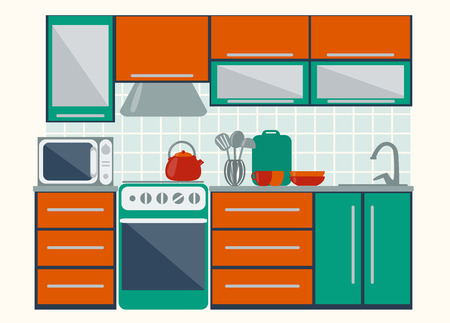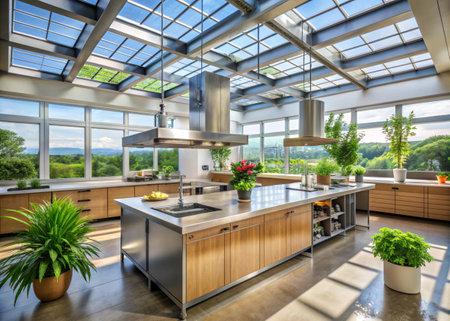Understanding the Basics of Layered Lighting
Layered lighting is a practical and stylish approach to illuminating your kitchen and dining room, especially when you want to create atmosphere without overspending. In UK homes, where rooms are often multi-functional and space can be at a premium, mastering the three primary types of lighting—ambient, task, and accent—is essential. Ambient lighting provides the general illumination that makes a room usable; in British kitchens, this might be achieved with flush-mounted ceiling fittings or energy-efficient LED panels that give a bright yet welcoming glow. Task lighting targets specific work areas, such as under-cabinet strip lights for prepping Sunday roast vegetables or pendant lamps above a dining table to make family meals feel inviting. Finally, accent lighting adds personality by highlighting features like a Welsh dresser displaying crockery or alcoves with open shelving. By understanding these layers and choosing budget-friendly options—like plug-in wall lights or retrofit LED bulbs—you can create both functional and atmospheric spaces tailored to the unique character of UK kitchens and dining rooms.
2. Setting a Budget and Prioritising Needs
Before diving into lighting choices, it’s crucial to set a realistic budget. Many UK households underestimate the costs involved in updating kitchen and dining room lighting, but with careful planning, you can achieve an atmospheric effect without overspending.
Guidance on Determining Your Spending Limit
Start by evaluating how much you’re comfortable investing in your project. Consider any upcoming expenses and decide whether your lighting refresh is a top priority. A helpful rule of thumb is to allocate around 5–10% of your total kitchen or dining room update budget for lighting alone. If it’s a standalone project, set an upper limit that won’t stretch your finances too thin—this might be anywhere from £100 to £500, depending on your ambitions.
Common Lighting Costs in the UK
It helps to know what typical fixtures cost. Here’s a quick overview:
| Lighting Type | Average Cost (per fixture) |
|---|---|
| Pendant Light | £30–£100 |
| Flush/Ceiling Light | £20–£80 |
| Under-Cabinet Strip | £15–£40 |
| Wall Sconce | £25–£70 |
| Dimmable LED Bulb | £5–£15 |
Keep in mind installation costs if you’re not going DIY—electricians in the UK typically charge between £40–£60 per hour.
Prioritising Essential Fixtures for Maximum Impact
If your budget is tight, prioritise fixtures that provide both functional and atmospheric benefits. For kitchens, focus first on task lighting above worktops and cooking areas; for dining rooms, invest in a statement pendant or chandelier above the table. Supplement with affordable ambient options like dimmable bulbs or plug-in wall lights to build layers without breaking the bank.
Top Tips for Getting the Most Value
- Shop during sales or at high street retailers like B&Q, IKEA, or John Lewis for bargains.
- Mix high-impact feature lights with cost-effective basics to stretch your budget.
- Reuse or upcycle existing fittings where possible—sometimes a new shade or bulb makes all the difference.
- Consider energy efficiency: LED options may cost more upfront but save money long-term.
A Thoughtful Approach Pays Off
By setting clear priorities and understanding typical costs, you’ll create a well-lit, inviting space that reflects both your needs and your budget. This groundwork ensures every pound is spent wisely as you move on to selecting and layering your new lighting scheme.

3. Affordable Lighting Choices for British Homes
When it comes to layering light on a budget in UK kitchens and dining rooms, the good news is that there are plenty of wallet-friendly options available. Whether you’re after something modern, traditional, or a bit quirky, the British high street is filled with accessible lighting solutions. Retailers such as IKEA, B&Q, Dunelm, and Argos regularly stock affordable ceiling pendants, wall sconces, and under-cabinet lights that help create layers without breaking the bank.
High Street Light Fittings
High street shops offer reliable choices for both style and function. For instance, simple glass pendants or metal shades can be picked up at reasonable prices, making them ideal for task or ambient lighting. Many retailers also feature mix-and-match collections so you can coordinate your kitchen and dining space without splurging on designer labels.
Second-hand and Vintage Finds
If you’re keen on sustainability and character, second-hand shops and online marketplaces like Gumtree or Facebook Marketplace are treasure troves for unique lampshades and fittings. Car boot sales and charity shops often yield bargains—sometimes classic British designs from previous decades—which can add warmth and personality to your home’s atmosphere.
Energy-efficient Bulbs in the UK Market
No matter which fittings you choose, opting for energy-efficient bulbs is a savvy move. LED bulbs are widely available from supermarkets and DIY stores across the UK. They use a fraction of the electricity compared to old incandescent bulbs and last much longer, which means further savings over time. Look out for bulbs marked with a warm white tone (typically 2700K-3000K) for inviting atmospheres in both kitchen and dining areas.
4. DIY Tips and Simple Upgrades
Transforming your kitchen or dining area’s lighting doesn’t have to break the bank or require a call to the electrician. With a bit of resourcefulness, you can introduce new layers of light and boost the ambience using affordable materials and straightforward techniques. Here are some practical tips tailored for UK homes, making use of readily available products and keeping safety in mind.
Easy Plug-In Lighting Solutions
If you’re renting or simply want to avoid rewiring, plug-in fixtures offer maximum flexibility. Table lamps on sideboards, under-cabinet LED strips, and battery-powered puck lights can all enhance specific zones without permanent installation. Look out for products with UK plugs and consider energy-saving LED bulbs to keep running costs low.
Popular Plug-In Upgrades
| Lighting Type | Best Use | Average Cost (GBP) |
|---|---|---|
| Plug-in Pendant | Over dining tables or kitchen islands | £20–£50 |
| Batteries/USB Puck Lights | Inside cabinets, shelves, or dark corners | £10–£25 (per set) |
| Clip-on Lamps | Worktops or reading areas | £8–£30 |
Minor Electrical Updates You Can Do Yourself
If you’re confident with basic DIY skills and follow UK electrical safety guidelines, swapping out old lamp shades or fitting new light switches can be a satisfying weekend project. Always isolate the power at the fuse box before starting any electrical work.
Simple Upgrades:
- Change Bulbs: Switch to warm-toned LEDs for a cosier feel.
- Replace Lampshades: Try fabric or rattan shades for a softer glow in dining spaces.
- Add Dimmer Switches: Many modern dimmers are compatible with LED bulbs—check packaging for “LED dimmable” labels.
- Pendant Height Adjustment: Shorten or lengthen cords using adjustable ceiling hooks; ideal for setting mood over tables.
Stylish Lighting Hacks Anyone Can Try
- Tape Fairy Lights Under Cabinets: This creates subtle task lighting and adds charm for evening meals.
- Painters’ Tape Patterns: Temporarily mask off designs on glass lamps for playful shadow effects.
- Candles & Lanterns: For special occasions, mix in candles or battery lanterns for instant warmth—just remember fire safety!
- Upcycle Old Fixtures: Spray paint tired metal fittings or add decorative washi tape for a quick refresh that matches your décor.
The key is to experiment and layer different sources until you achieve both practicality and atmosphere. By combining these small-scale improvements, you’ll find it’s entirely possible to create inviting, well-lit kitchens and dining rooms—without overspending or calling in professionals.
5. Creating Atmosphere with Local Touches
One of the most delightful aspects of lighting your kitchen or dining room is the chance to infuse a bit of local British charm while staying on budget. Layering light doesn’t have to be clinical—its about creating warmth and character that reflect your home’s personality. Start by combining different types of lighting: overhead pendants provide general illumination, while wall sconces or table lamps can offer softer pools of light for a more intimate setting.
Layering with Dimmers
Dimmers are a cost-effective way to adapt your atmosphere from morning bustle to cosy evening meals. Swapping standard switches for dimmers lets you fine-tune the brightness, instantly making even a modest flat feel more inviting. Dimmable LED bulbs are widely available in the UK and easy to retrofit into existing fixtures.
British Design Elements
To give your space unmistakable British character, look for patterned lamp shades in classic motifs like William Morris prints or tartans. These add texture and visual interest while diffusing light softly across the room. Vintage finds from charity shops or car boot sales—like an old brass reading lamp or retro glass pendant—can be rewired for safety and paired with modern bulbs for energy efficiency.
Personalising Your Space
If you’re after a subtle country-cottage feel, opt for warm white bulbs and natural materials such as linen, rattan, or ceramic bases on your lamps. For a more urban look, industrial-style metal fixtures or exposed bulbs work well, especially when softened with fabric shades or paired with dark-painted walls. Don’t be afraid to mix new purchases with heirlooms or upcycled treasures; this blend is quintessentially British and ensures your layered lighting feels truly personal.
6. Maintaining and Upcycling Existing Lights
When working within a tight budget, maintaining and upcycling your current lighting fixtures is both practical and rewarding. Rather than replacing everything, you can give your kitchen or dining room a fresh lease of life by revamping lights you already own. Here are some ideas tailored for UK homes that blend creativity with frugality.
Refresh with Paint
A quick coat of paint can dramatically change the look of tired fittings. Opt for metal-safe spray paints or chalk paint for a trendy matte finish—ideal for pendant shades, wall lights, or even lamp bases. Choose colours that complement your kitchen cabinets or dining room décor; muted greys, deep blues, or classic black are popular in many British homes.
Tip:
Always remove electrical components and clean the fixture thoroughly before painting. Use masking tape to protect areas that should not be painted.
Rewiring for Safety and Style
Many older UK properties have beautiful period features but may come with outdated wiring. If you love the style of an existing fixture but it’s seen better days, consider rewiring it rather than discarding it. This can often be done affordably by a qualified electrician, ensuring safety and compliance with UK standards while preserving the charm of your original lights.
Bonus:
Switching to energy-efficient LED bulbs during rewiring will also help lower your electricity bills in the long run.
Repurposing and Mixing Styles
Think creatively about how fixtures might serve new purposes. An old pendant light could become a cluster feature above the dining table, or mismatched wall sconces could be grouped for an eclectic gallery effect. In true British fashion, mixing vintage finds with modern elements adds character and warmth to your living spaces without overspending.
Sourcing Materials
Look to local charity shops, car boot sales, and online marketplaces like Gumtree or Facebook Marketplace for bargain light fittings or spare parts. Often, you’ll find unique pieces just waiting for a little TLC.
Caring for Your Lights
Regular dusting and gentle cleaning will keep your fixtures looking their best. For glass shades, use a mild soap solution; for metals, a soft cloth will prevent scratches. Well-maintained lights last longer and continue to enhance the atmosphere of your kitchen and dining areas.
By choosing to maintain and upcycle, you not only save money but also contribute to sustainability—a value increasingly important in UK households. With a bit of imagination and care, it’s entirely possible to achieve layered lighting that feels bespoke without breaking the bank.


